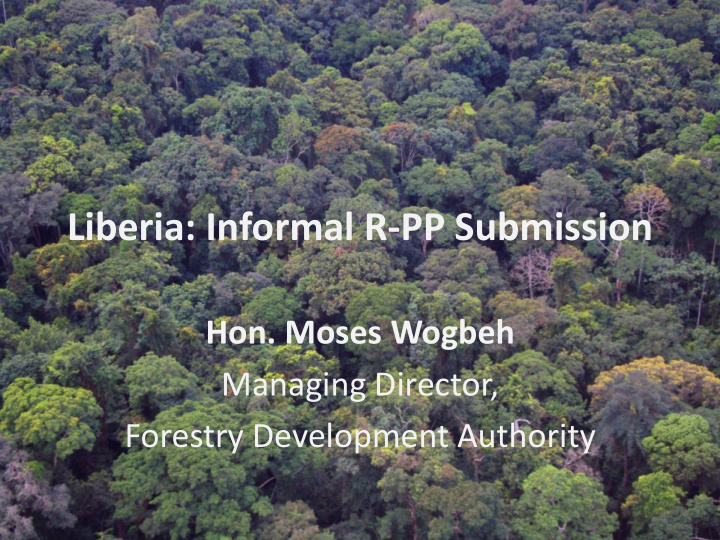



Liberia: Informal R-PP Submission Hon. Moses Wogbeh Managing Director, Forestry Development Authority
Liberian Forest Sector • Population is 3.5 million (2010) • Total land area is 9.58 million ha • Forest cover is 4.5 million ha – This constitutes 43% of the Upper Guinean Tropical Rainforest • These forests are a biodiversity hotspot and a priority for global conservation
Biodiversity in Liberia • Charismatic mega-fauna includes: – 12 species of threatened primates, including Chimpanzees – Forest elephants – Leopards and other carnivores • A raft of lesser known but rare and often endemic species, including: – Zebra duiker (endemic) – Pygmy hippopotamus (endemic) – Over 2000 flowering plants / 225 timber species
Forest cover in South East Liberia (2011)
Threats to the forest • Post-conflict • Widespread poverty and unemployment • Competing interests and land values: – Diamonds – Gold – Iron ore – Commercial timber extraction – Oil palm production – Rubber plantations – Other cash crop production (cocoa, coffee, etc)
Shifting cultivation in Sinoe County, S.E. Liberia
Forest Governance • Forest ecosystem and resources managed by the Forest Development Authority (FDA) – By an act of the National Legislation 1976 • Overall aim is to manage the forest of Liberia for the benefit of the people so it may continue to provide a wide range of goods and services • FDA has a board which is chaired by the Ministry of Agriculture, however it is an independent agency of the Liberian Government
Forest Sector Reform • UN Security Council imposed sanctions on the export of timber and forest products in 2003 – Revenues were being used to fuel conflict in the sub- region • Forest sector reform was a key prerequisite for the removal of sanctions • In 2006 the sector reform was undertaken, putting into place legal requirements, including: National Forest Policy; National Forestry Reform Law (2006); Community Rights Law; Draft Wildlife and Conservation Law; among others
The “three C’s approach” • The key result of the forest sector reform was the development of the 3 C’s approach – a mechanism to balance the use and protection of the forest: 1) Community Forest 2) Conservation Forest 3) Commercial Forest
REDD+ in Liberia • Opportunities made possible by the forest sector reform, community based development approaches and unique political / development situation has provided the ideal foundation for producing a national REDD+ model • Following the Bali COP, Liberia submitted an R- PIN to the FCPF. The R-PIN was successfully received and Liberia was granted $200,000 USD to develop the R-PP
• REDD Technical Working Group (RTWG) launched – In June 2009, the Government of Liberia established a National REDD+ Technical Working Group composed of representatives from Government including the Energy, Environment and Climate Change Advisor to the President, NGOs, INGOs, civil society, private sector, and academia. – RTWG given responsibility to lead a participatory REDD+ development process in Liberia, including the drafting of the R-PP
R-PP Development & Consultation • An R-PP drafting team was selected with representatives from GoL, CSO, NGO and INGO to lead on a consultative and participatory process throughout Liberia – Workshops held at the grassroots (local) levels, county level and multi-stakeholder engagement with key line ministries and agencies of government at the national level – Five drafts of the R-PP produced using this iterative process with discussions held and comments received, from all stakeholders, at each stage – R-PP consultation and particpation has been built on processes designed for the VPA (FLEGT), LEITI consultation process, Benefit Sharing Mechanism and the SEA of forestry sector
Discussion on REDD+ & R-PP with Sapo National Park and Sinoe Community members
R-PP TAP Comments & Revisions Following the TAP/PC comments, revisions are being made and a revised R-PP draft will be resubmitted in June…
REDD+ in the wider context • FLEGT / VPA is currently in the final negotiation between Liberia and the EU • Chain of Custody System – An independent institution in Liberia who is tasked with the legal tracking of timber from stump to port of exit • LEITI (Liberia Extractive Industries Transparency Initiative) – Public disclosure of ALL revenues from timber, rubber, minerals, oil palm etc • Land Commissioner appointed to regulate critical and competing land issues, relating to the 3 C’s
• Benefit Sharing Mechanism (Could serve as example for REDD plus) – BSM procedures and structure now in place for communities to access revenue from timber concessions – Communities participated fully throughout the two year establishment process; – Long process to harmonise different community approaches to benefit distribution, based on their traditions, into a standardised mechanism; – Regulations approved; – Trust Boards constituted to manage funds • Community Rights Law – Recognizes the RIGHT of communities to manage, own and benefit from forest resources – And formulated using a comprehensive consultative process
R-PP Key opportunities • Political will – at all levels – is in place to develop REDD+ • Community Forestry and local empowerment is well developed in Liberia • Strong institutions, policy, laws and mechanisms already in place to help facilitate the REDD+ development process • Inter-ministerial / agency coordination exists within the National Climate Change Steering Committee and National CC Secretariat which are both housed within the Office of the President (critical for issues around land use planning)
R-PP Remaining Challenges • Post-conflict issues remain: Poverty, food security and forest dependency • Capacity gaps for the implementation of the R-PP remain very significant, within GoL, civil society and local forest dependent communities • Improved land use planning is required • Deforestation and degradation baselines need to be consolidated, approved and shared
Conclusion Thank you for your attention and support
Recommend
More recommend